In a six-game match, the first blow is worth a few euros. Ivan Sokolov thoroughly realized this today when he went for the kill with white, striving for a ‘V for Victory’ pawn formation (d5-e4-f3-g4-h5). He didn’t quite complete the V, but he did the victory. And the Bosnian Dutchman was clearly very happy with that.
‘Did you have a special plan for today?’ commentator Jop Delemarre asked Sokolov after his win. ‘Yes’, he replied. With a firm full stop after this sentence.
Sokolov - Van Foreest
1.c4 Nf6 2.Nc3 g6 3.e4 d6 4.d4 Bg7 5.Be2 0–0 6.Be3 e5 7.d5 a5 8.g4 Na6 9.g5 Ne8
Here the game started for Sokolov. He had analysed 9...Nd7. As Jop Delemarre explained in the commentary room, White’s plan is not to build up an attack on the black king, but to paralyse the black initiative there and then eventually strike on the queenside, where White is superior in the King’s Indian.
10.h4 Nc5 11.h5 Bd7 12.Nf3 c6 13.Nd2 a4
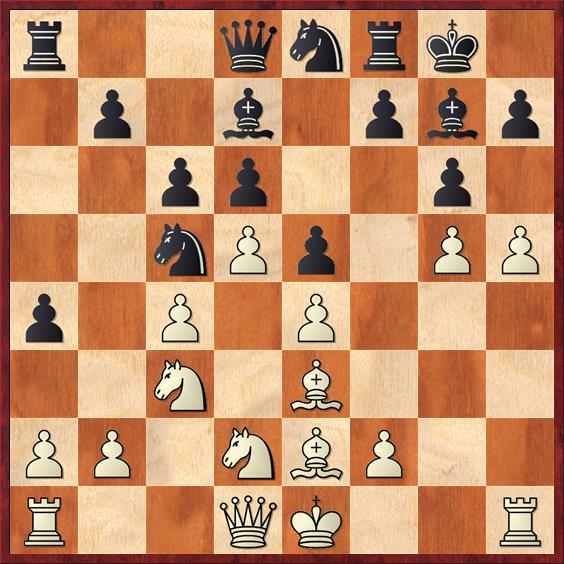
14.b4!?
Loek van Wely criticized this move. ‘You shouldn’t play on two wings’, the tournament director instructed. Russian specialists continue quietly here with 14.Qc2 and queenside castling. Sokolov was quite satisfied with his play here.
14...axb3 15.axb3 Rxa1 16.Qxa1 Na6 17.Kf1 Nb4 18.Qb1 Nc7
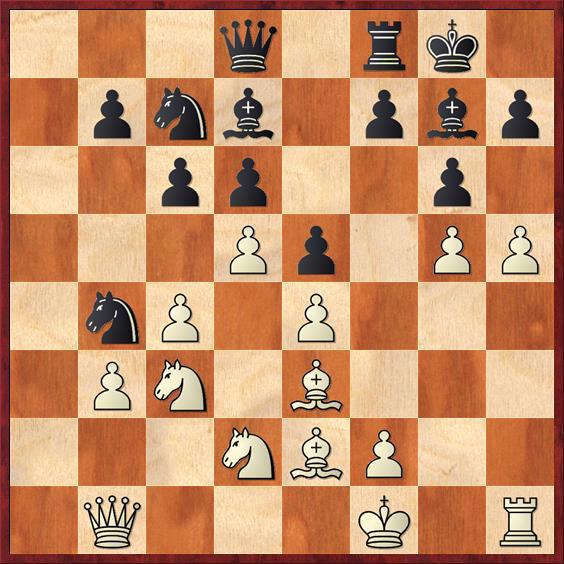
At this moment Sokolov said to himself: ‘Do I want to allow two black knights on b4 and c5?" The answer was ‘no’. But he regretted his next move afterwards.
19.Na2 cxd5 20.cxd5
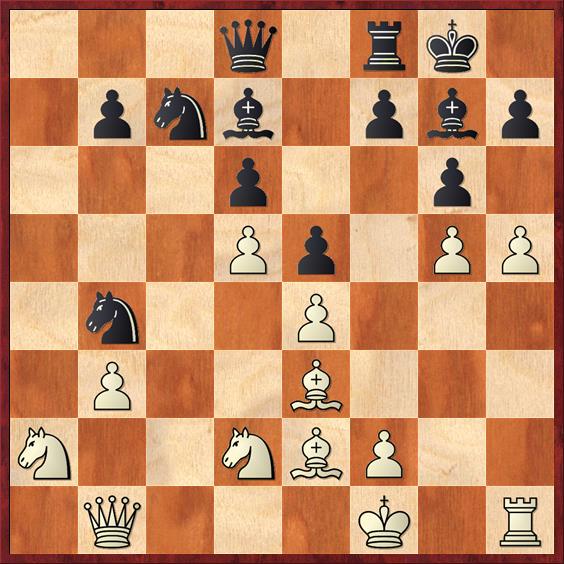
20...Nxa2?
The breaking point, according to both players. Black should have seized his chance here with 20...Nbxd5! 21.exd5 Nxd5. ‘Then he can play for three results, whereas after the text he can only play for two’, said Sokolov. Van Foreest had considered the move, of course, but he gave a characteristic explanation for his choice: ‘I thought my position was OK anyway.’

Sokolov shows the game to the audience and commentator Jop Delemarre. Photo: Lennart Ootes
21.Qxa2 Nb5 22.Bxb5 Bxb5+ 23.Nc4
‘Now Black is in trouble’, Sokolov claimed.
23...Qc8
With hindsight, Van Foreest didn’t approve of this move. ‘23...f5 immediately was better.’
24.Qe2 f5 25.gxf6 Rxf6 26.Bg5
Delemarre said: ‘From here on, Sokolov killed the position in five moves.’ g6 is a painful weakness.
26...Rf7 27.hxg6 hxg6 28.Kg2 Rc7 29.Rc1
This rook can move to g3 through c3.
29...Bf8 30.Rc3 Ba6?!
Missing his last chance to protect g6, but the bishop on e8 wasn’t a pleasant prospect either.
31.Rg3
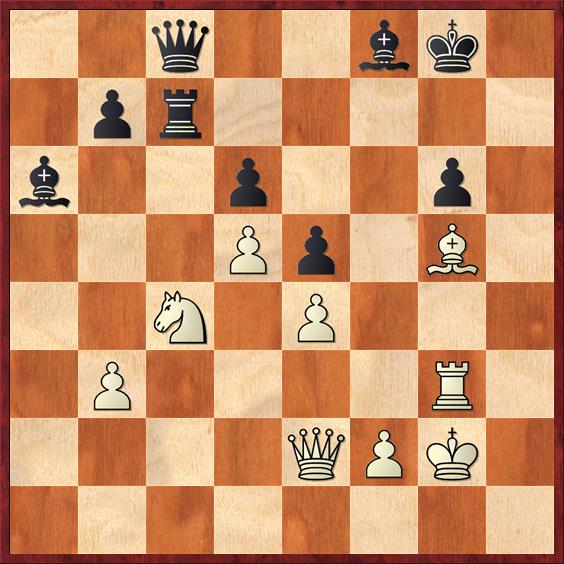
31...b5
And here he misses his last chance to defend. After 31...Bxc4! 32.bxc4 Rxc4 White seems to win in the attack, but it’s not clear:
-
33.Bd8 Bg7 (33...Rc2? 34.Qh5! Rxf2+ 35.Kxf2 Qc5+ 36.Kg2 and the king walks to h3) 34.Rxg6 Rc2 35.Qg4 Qxg4+ 36.Rxg4 Kf7 37.Be7 Bf8+= had been calculated by Sokolov; 38.Bxf8 Kxf8 39.Rg6 wins a pawn for White, but according to the experts (Delemarre and Lucas van Foreest) this endgame is a draw;
-
33.Be7 Rc7 34.Rxg6+ Kf7 35.Qh5 Kxe7 36.Re6+ Qxe6 37.dxe6 Kxe6 also seems to be unwinnable for White; he won’t manage to carry through both f2-f4 and e4-e5 in favourable circumstances.
32.Ne3 b4? 33.Qf3
Missed by the black player, especially White’s next move.
33...Bg7 34.Bf6 Rf7 35.Rxg6 Qf8 36.Ng4 Qc8 37.Nh6+ Kh7 38.Qh5
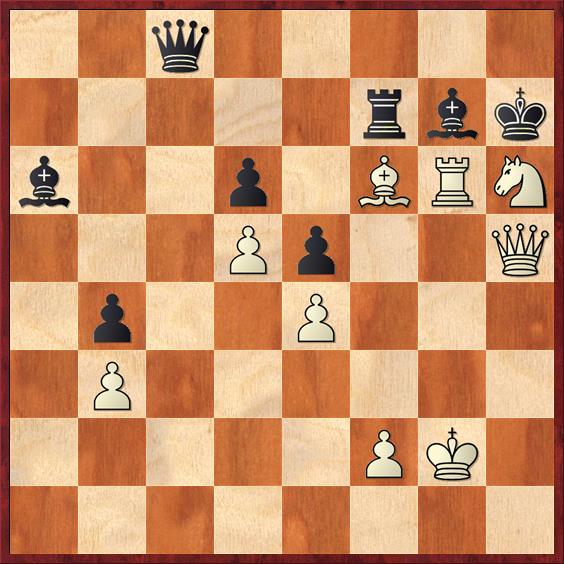
38...Bf1+ 39.Kxf1 Qc1+ 40.Kg2 Bxh6 41.Rxh6+ 1–0
However, Van Foreest didn’t lose his sense of humour either. Shortly after the game he entered the pressroom with the book ‘Kotronias vs the King’s Indian’ in his hands, and even allowed us to make a picture.

Jorden van Foreest with his new book. Photo: Lennart Ootes

Ivan Sokolov. Photo: Lennart Ootes
The first battle of the sexes was a grim struggle. Hou Yifan was given a hard time, but she stayed afloat.
Short – Hou Yifan
For the statisticians: in classical games the score between these two players is 3-3. Both had won 1 game – by the way, Hou Yifan won first, in Wijk aan Zee 2008, in 23 moves. In 2012, Hou Yifan and Short entered a playoff to determine the tournament victor at the Gibraltar Open, won by Short 1½–½.

Hou Yifan and Nigel Short at the opening ceremony. Photo: Lennart Ootes
1.Nf3 Nf6 2.g3 d5 3.Bg2 b5!?
Aimed against c2-c4 – running the risk however that with a little preparation this move may come with greater effect later on.
4.0–0 Bb7 5.d3 e6 6.c4 a6 7.cxd5 Nxd5
After 7...exd5 White has the strong 8.d4!.
8.a4 Be7 9.Nc3 0–0 10.axb5 Nxc3 11.bxc3 axb5 12.Rxa8 Bxa8 13.Qb3!
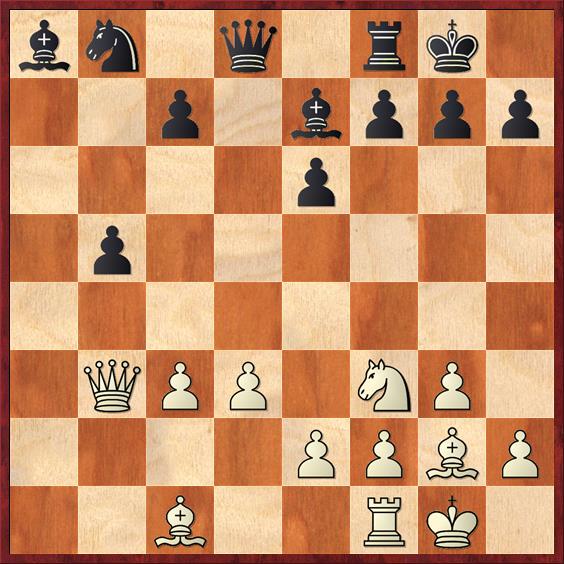
b5 remains a hot issue: after Black’s reply the c7-pawn remains backward.
13...Bc6
Objectively best was perhaps 13...Qd5, but exchanging queens at such an early stage is not Hou Yifan's style.
14.Be3 Nd7 15.Ra1 Qc8
When asked what had gone wrong, the Chinese replied: ‘There’s not one single move, I made a few passive moves.’ Perhaps this one was not so accurate: on the next move the queen makes another step.
16.Ra7 Qb8 17.Qa2 b4
This does not work out very well either; the wait-and-see move 17...Bd6 was the alternative.
18.cxb4 Bxb4 19.Nd4 Bxg2 20.Kxg2 Bc5?!
20...Ne5 would have prevented White’s strong next.
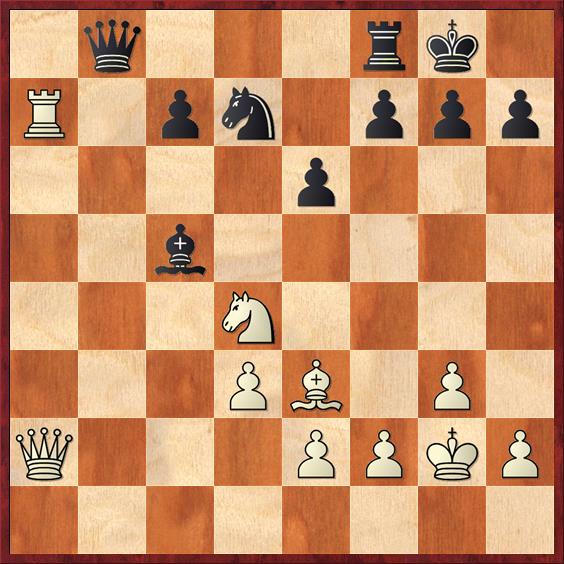
21.Nc6! Qb6 22.Ne7+! Kh8 23.Bxc5 Qxc5 24.Qa3 Qb6
Afterwards, the players looked briefly at the 'active' 24...Qc2 – which goes horribly wrong after 25.Ra8! Qxe2?? (25...Rb8 26.Qa6! and there is no good remedy against the threat of 27.Rxb8+ and 28.Qc8+) 26.Rxf8+ Nxf8 27.Qa8 with dull misery.
25.Qa5
Now the queens go off anyway, as otherwise Black loses a pawn with 25...Qd6 26.Qxc7 Qxe7 27.Qxd7. ‘I was considering going into the 5 vs 4 rook ending’, Hou Yifan said. ‘That is incredibly unpleasant’, Short replied, ‘maybe even lost.’
25...Qxa5 26.Rxa5 g6 27.Ra7 Re8 28.Nc6 Rc8
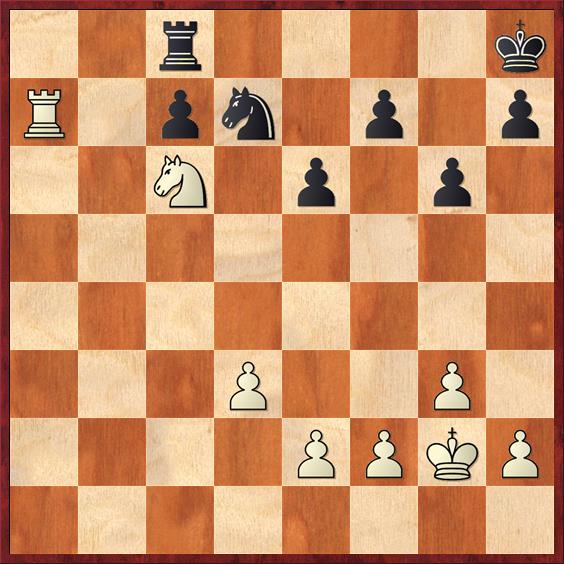
This is also highly unpleasant for Black. But could White have won somewhere? Both players didn’t dare to say.
29.f4 Kg7 30.Kf3 Kf8 31.g4 Ke8 32.g5 Nb6 33.e4 Kd7 34.Ne5+ Ke7 35.Ke3
Hou Yifan suggested that White might have tried 35.Rb7 somewhere. This move indeed looks favourable at this moment – Black finds herself in a kind of zugzwang. For example: 35...f5 36.gxf6+ Kxf6 37.Nc6 h6 (37...Kf7? 38.Na7 is an important point of Nb7) 38.h4 g5 39.Kg4 h5+ 40.Kg3 gxf4+ 41.Kxf4 Kf7 (if the knight budges, for instance with 41...Nd7, White pushes through with 42.d4) 42.Na7 Rg8 43.Rxc7+ Kf6 and this looks tenable after all in view of 44...Rg4+.
35...f6!
Now this is an important defensive move – otherwise Black will succumb to a shortage of space.
36.gxf6+ Kxf6 37.h4 Ke7 38.Ra2 Nd7 39.Nc6+ Kd6 40.Rc2 Nc5?!
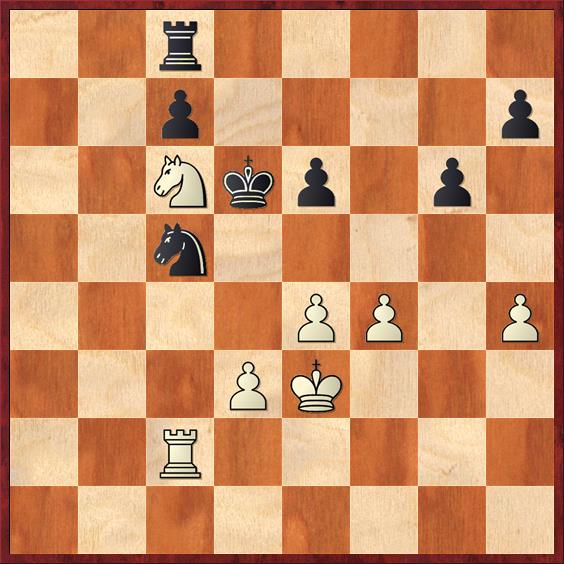
Allowing a little trick. After 40...Nf8 it’s hard to see how White can make progress.
41.Ne5?!
41.Na7! Ra8 42.Nb5+ Kc6 43.Nxc7 Kxc7 44.Rxc5+ and now (involuntarily!) there is a 4 vs 3 rook ending on the board. Is it a win? Hard to say. Agony for Black? Definitely. Especially since h4-h5 is coming.
41...Nd7 42.Rc6+ Ke7 43.Kd4
This looks like a tight spot for Black, but by manoeuvring the knight she manages to hold. The following phase doesn’t show any more clear attempts by White.
43...Nf6 44.Rc5 Ne8 45.Ra5 Nf6 46.Ra7 Nh5 47.Ke3 Nf6 48.Nc6+ Kd7 49.Ra6 Rf8 50.Ne5+ Ke7 51.Rc6 Rc8 52.Nc4 Kd7 53.Ra6 Rf8 54.Ne5+ Ke7 55.Ra7 Rc8 56.Nc4 Ne8 57.Ne5 Nf6
And Short ceded his attempts with the remark, ‘Come on, let’s eat.’ ‘Mm, he could have played on for a bit’, muttered Loek van Wely, who seems to become even more belligerent when he cannot play himself.
½–½
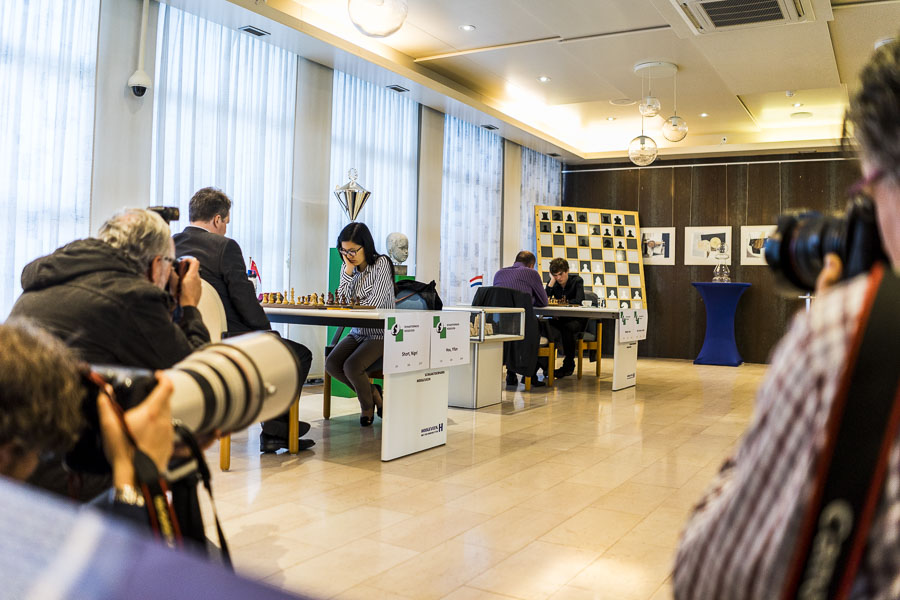
Photographers at the start of the round. Photo: Lennart Ootes

Hou Yifan. Photo: Lennart Ootes

 .
. 





















